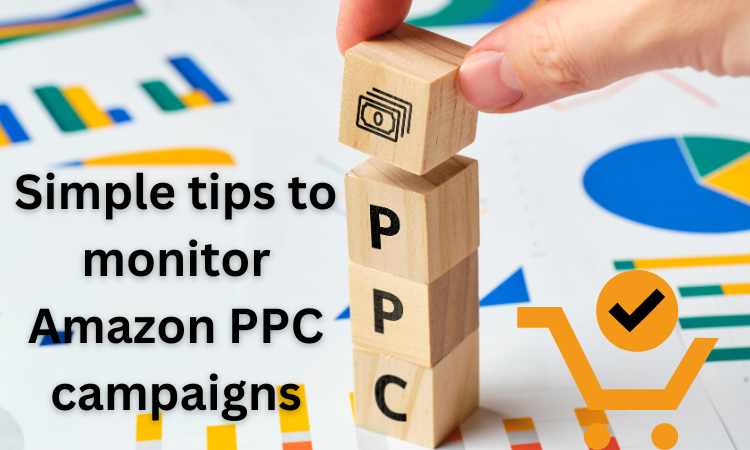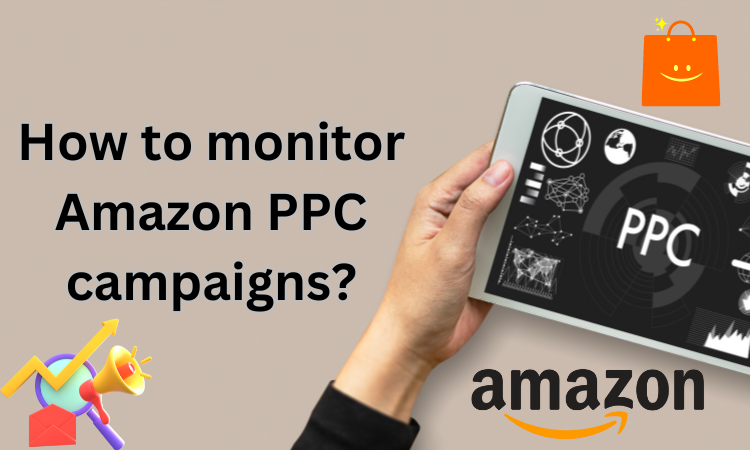If you’re selling items on Amazon and using Pay-Per-Click (PPC) ads to get noticed, you’re on the right track. But here’s the thing, just starting the ads isn’t enough.
You have got to keep an eye on them to make sure they’re working well. In this guide, we will show you the easy ways to keep tabs on your Amazon PPC ads.
Simple tips to monitor Amazon PPC campaigns:
Here are some simple tips that can help you effectively monitor your Amazon PPC campaigns.

Monitor Amazon PPC campaigns with Amazon Advertising Console:
This is your primary in-house tool for Amazon PPC monitoring. Here are the multiple metrics you should check to monitor Amazon PPC campaigns effectively and for free:
Impressions:
Impressions show how many times people see your Amazon ad. Check this number on the Amazon Advertising Console to know if your ad is reaching more customers.
More impressions means more people are seeing your ad, while a sudden drop may indicate issues with targeting or bids.
Observe your Amazon PPC campaigns impressions to adjust your campaign and make sure your product gets noticed in Amazon PPC campaigns, helping boost sales on Amazon.
Clicks:
Watch how many times people click on your ads when you run Amazon PPC campaigns using the Amazon Advertising Console.
Clicks show how many times people tap on your ad. More clicks mean folks are interested in your product, showing your campaign is doing well.
If clicks are low, you might need to tweak your ad or targeting. Always check your click data to improve your strategy and make sure your ad grabs attention, bringing more visitors to your Amazon product page.

Cost Per Click (CPC):
Observe Cost Per Click (CPC) when handling Amazon PPC campaigns with the Amazon Advertising Console. Cost per click (CPC) is the amount you’re charged whenever someone clicks on your PPC ad.
Watching CPC helps you know how much you’re spending to bring people to your product. Lower CPC is good because it means spending less for each click.
If your CPC is high, think about adjusting your bid or improving targeting to save costs. Regularly check your CPC data to make sure you’re using your ad budget wisely and making the most of your Amazon PPC campaign.
Conversion Rate:
Pay attention to the Conversion Rate when checking your Amazon PPC campaigns on the Amazon Advertising Console.Conversion Rate shows the percentage of clicks turning into actual sales.
A high rate means your ads are working well. Check this regularly to make sure you’re reaching the right customers and your product pages are convincing.
If the rate is low, tweak your ads, improve product info, or change keywords. This helps you adjust and make sure your Amazon PPC efforts bring in good returns.

Total Sales & Total Spend:
Keep an eye on Total Sales and Total Spend when handling Amazon PPC campaigns using the Amazon Advertising Console.
Total Sales show how much money your ads make, while Total Spend indicates your advertising costs. If your sales are higher than your spending, that’s good news—it means your ads are working well.
But if spending is more than sales, consider tweaking your strategy, like improving keywords or ad content. Checking these numbers regularly helps you make sure your Amazon PPC campaigns are making money for you.
Advertising Cost of Sales (ACOS)
When keeping tabs on Amazon PPC campaigns through the Amazon Advertising Console, don’t forget about Advertising Cost of Sales (ACoS).
This metric is a key indicator of how efficiently your ads turn clicks into sales. ACOS is the percentage of your sales revenue spent on advertising.
A lower ACOS is generally better, as it means you’re getting more value from your ad investment. Regularly check your ACOS to ensure your campaigns are cost-effective.
If it’s high, consider refining your keywords, improving ad content, or adjusting your bidding strategy to optimize your advertising spending and boost overall campaign profitability.

Return on Ad Spend (ROAS)
When you are watching your Amazon PPC campaigns on the Advertising Console, pay attention to Return on Ad Spend (ROAS).
This tells you how much money your ads make compared to what you spend. A higher ROAS means your ads are making more money, which is good.
Check ROAS regularly to see if your campaigns are doing well. If it’s not as high as you want, try improving your ads or choosing better keywords to make your Amazon PPC efforts more profitable.
Return on Investment (ROI)
It is important to pay attention to Return on Investment (ROI) when you’re watching your Amazon PPC campaigns on the Advertising Console.
ROI shows if your ads are making more money than you spent. A higher ROI means your campaigns are more profitable.
Check ROI regularly to make smart decisions about your ads. If it’s not as high as you want, try improving keywords, making better ads, or changing bidding strategies.
This helps make sure your Amazon PPC efforts are not just bringing in sales but also making good financial sense for your business.

Conclusion:
At last, we can say it’s crucial to monitor Amazon PPC campaigns to make sure they’re working well.
But you can do this by checking numbers like how many times your ad is seen, how many people click on it, and how much you’re spending on each click.
Also, look at how many clicks turn into actual sales and compare your sales to how much you’re spending on ads. These metrics help you figure out if your ads are making you money or not.
Frequently Asked Questions:
What is an Amazon PPC campaign?
An Amazon PPC (pay-per-click) campaign is a way for sellers to advertise their products on Amazon’s marketplace.
Sellers create ads targeting specific keywords, and their ads appear in search results and product listings. They are only charged when a customer clicks on their ad.
What is PPC monitoring?
PPC monitoring is the ongoing process of tracking and analyzing the performance of your Amazon PPC campaigns.
This involves checking key metrics like clicks, impressions, cost-per-click (CPC), and conversion rate.
What is the most important metric to track for Amazon PPC campaigns?
There isn’t a single most important metric, but Advertising Cost of Sales (ACoS) is a crucial one. It shows you how much of your ad spend translates to sales. For best results, your advertising costs (ACoS) should be less than the profit you make on each sale.
How do I track my PPC campaign?
Amazon Ads provides reporting tools that allow you to track various metrics for your campaigns. You can also use third-party PPC management tools for more advanced tracking and analysis.
How do you evaluate a PPC campaign?
Evaluating a PPC campaign involves analyzing metrics like ACoS, conversion rate, return on ad spend (ROAS), and impressions. You should also consider your campaign goals (increased sales, brand awareness) to determine success.
How can I learn Amazon PPC?
There are many resources available to learn about Amazon PPC, including:
- Amazon Ads Help Center: https://www.sellerapp.com/blog/amazon-ppc-basics/
- Online Courses: Many platforms offer courses on Amazon PPC advertising.
- Blogs and Articles: Websites like Jungle Scout and Helium 10 offer valuable PPC resources.
How does Amazon PPC bidding work?
With Amazon PPC, you set bids for the keywords you want to target. Your bid determines how much you’re willing to pay when someone clicks on your ad. There are different bidding strategies, like automatic and manual bidding, allowing you to optimize your campaigns for your goals.
How do you manage PPC campaigns?
- Track key metrics (impressions, clicks, costs, conversions).
- Analyze data to identify strengths and weaknesses.
- Adjust bids, keywords, and ad copy to improve performance.
What is the KPI in Amazon PPC?
Amazon PPC doesn’t have a single, universal KPI.
However, several key metrics play a crucial role in measuring campaign success, depending on your goals. These include:
- ACoS (Advertising Cost of Sale): Measures cost-efficiency (lower is better).
- Conversion Rate: Tracks the percentage of clicks that lead to sales.
- ROAS (Return on Ad Spend): Indicates your return on investment (higher is better).
What is the most important PPC KPI to monitor?
While there isn’t a single “most important” PPC KPI, the one you prioritize depends on your campaign goals:
- For immediate sales: Conversion rate or ROAS (Return on Ad Spend)
- For brand awareness: Impressions or Reach
What are PPC metrics?
PPC metrics are data points that measure the performance of your pay-per-click advertising campaigns. They offer insights into areas like:
- Visibility: How often your ads are seen (impressions)
- Engagement: How many people click on your ads (clicks, CTR)
- Conversions: How many clicks lead to desired actions (sales, leads)
- Cost: How much you spend per click (CPC) and overall (ACoS)
- Return: How much revenue you generate from your ad spend (ROAS)
What are the 4 C’s of PPC?
The 4 C’s of PPC is not a widely used framework in the PPC industry. While “4 C’s” frameworks exist in marketing, they typically refer to Customer, Cost, Convenience, and Communication.
What are the 5 key aspects of PPC?
Here are the 5 key aspects of PPC:
- Targeting: Identifying the right audience to show your ads to, using demographics, interests, and keywords.
- Bidding: Setting a price you’re willing to pay for each click on your ad.
- Ad copy: Creating compelling and informative ads that grab attention and convince people to click.
- Landing page: Ensuring your website page linked to the ad is relevant and optimized for conversions.
- Monitoring and optimization: Tracking performance metrics, analyzing data, and making adjustments to improve results over time.
What is PPC performance?
PPC performance refers to how well your pay-per-click (PPC) advertising campaigns are achieving your goals. You measure it by tracking key metrics like clicks, conversions, and cost efficiency.
- Good PPC performance: Many people see your ad, click on it, and end up buying your cookies (conversions). You’re reaching the right audience and getting a good return on your ad spend.
- Poor PPC performance: Few people see your ad, even fewer click on it, and no one buys your cookies. You’re not reaching the right audience or your ad isn’t convincing enough.
What is a good PPC?
A “good” PPC campaign is subjective and depends on your specific goals. However, it generally achieves:
- Desired outcomes: Increases sales, brand awareness, website traffic, etc., as per your goals.
- Positive return: Generates revenue exceeding the advertising cost (positive ROI).
- Cost-effectiveness: Achieves goals at a sustainable cost (good ROAS and CPC).
More on PPC:

